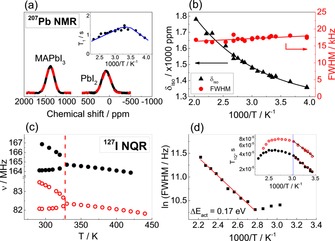Figure 4.

a) Experimental 207Pb NMR spectra of MAPbI3 and PbI2 for comparison. Inset: Spin‐lattice relaxation T 1 as a function of temperature. The dependence is rather weak and is similar to what was reported for pure PbI2.48 b) Temperature dependences of the 207Pb chemical shift and FWHM. Solid lines are a guide to the eye. A very short spin‐spin relaxation time T 2 (ca. 2×10−5 s) is detected for this signal, which is consistent with strong dipolar coupling and particularly cross‐relaxation to quadrupolar 127I.49 c) Temperature dependence of 127I NQR transition frequencies (•=ν±3/2↔±5/2, ○=ν±1/2↔±3/2) in MAPbI3, demonstrating the phase transition at 327 K. d) Temperature dependence of the linewidth in ν1 NQR transition of MAPbI3. Inset: Temperature dependence of the spin‐spin relaxation time in the two 127I NQR transitions of MAPbI3 (•=ν±3/2↔±5/2, ○=ν±1/2↔±3/2). Blue line indicates phase transition.
